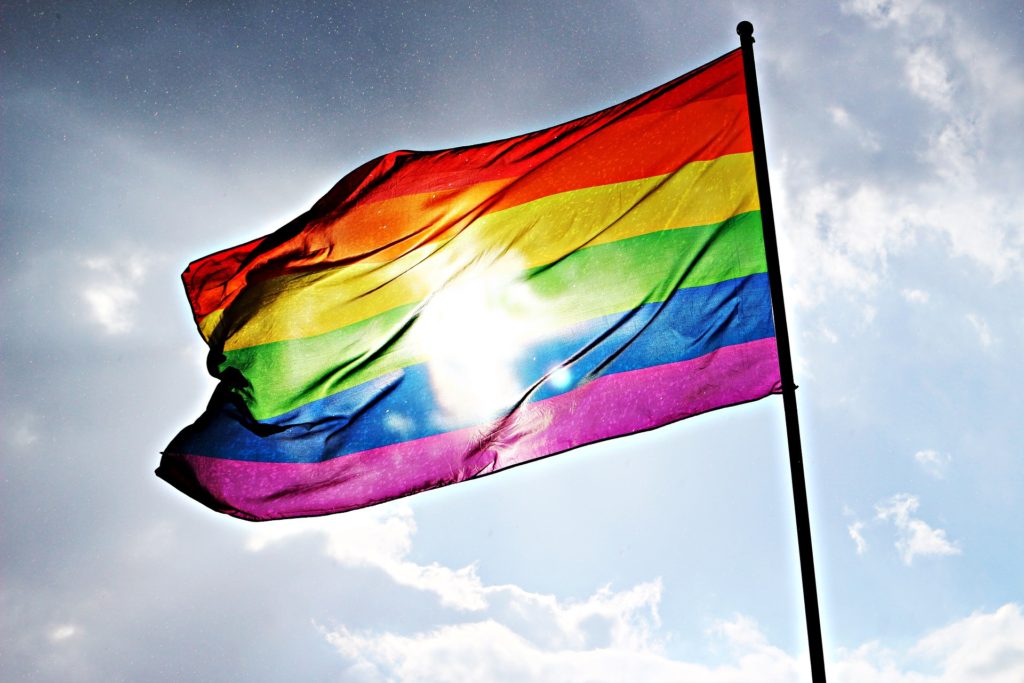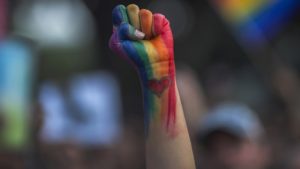One year after Pulse: How can parents empower kids to rise above LGBTQ+ hate?
Special thanks to Andy Garcia of the Equality Federation, and Boyd and Beth Bellinger for their insight
One year ago I woke up in a hotel room in Jackson Hole, Wyoming, to some very bad news.
“There was a shooting in Orlando last night,” my husband whispered through the dark room, our five kids and my brother-in-law still sound asleep.
“That’s awful,” I said. “Did anyone die?”
His voice quivered a bit.
“Yes, a lot of people died.”
As we packed up our family to head to Grand Teton National Park and Yellowstone National Park – the first time any of us had ever been either place – our hearts were heavy. My husband works at the Orlando Sentinel and knew that his colleagues were working non-stop to cover the story while we were enjoying our children, snapping photos next to some of the most beautiful spots on earth. He was receiving text alerts and email updates along with the rest of the staff and even wrote in to offer to help from his computer in Wyoming. He was told to just enjoy his children and earned time off. It was hard though, for both of us, to focus on what was in front of us because so much despair was happening back home. It would be another 18 days before we arrived back home to signs declaring #OrlandoUnited and people moving through the process of grieving, as individuals and a city.
In the weeks and months that followed the Pulse shootings, like other Americans, I searched my heart for answers. Like other parents, I mourned with the mothers and fathers who had to bury their children. More than a few times, when reading beautifully-worded obituaries in the Orlando Sentinel and other places, I asked “Why?” There was never an answer and as time passed, and as the motive behind the shooting became apparent, I felt even more at a loss.
Here are some sobering stats (sources listed at the bottom of the article):
- LGBTQ+ people are the most likely minority group to be targets of hate crimes in the U.S., followed by Jewish, Muslim and Black Americans.
- LGBTQ+ crimes go largely unreported; in 2014, only a single one was reported in the state of Mississippi, while Connecticut had 23.
- Between 2012 and 2015, the largest group killed through hate crimes were Black transgender women, followed by Black gay men, white gay men and Latino transgender women.
When it comes to LGBTQ+ youth:
- LGBTQ+ youth are two to three times more likely to attempt suicide than their peers – if the family is opposed to their orientation, that number jumps to EIGHT times more likely.
- 44 percent feel unsafe at school due to gender orientation.
- 44 percent experience physical harassment at least once during the school year.
- 22 percent experience stronger violence.
- 31 percent say the school makes no effort to intervene.
Even before (and after) the Pulse tragedy, too many people are being victimized; too many families are burying loved ones.
I started to wonder – am I doing enough to prevent senseless crimes like these? Or am I just shaking my head in brief sadness and moving on with the rest of my comfortable life?
More specifically, I wondered: Do I speak out enough for the people around me who need it – for those who are being unfairly treated? Am I setting the right example for my five children when it comes to standing up for, speaking out for, and actively supporting those who identify as LGBTQ+ and other marginalized groups?
I reached out to a few friends who are part of the LGBTQ+ community, and some who work toward furthering justice for those groups, and asked HOW I could be a bigger part of the solution, starting with the way I’m raising my kids. Combined with their responses and some other research I’ve done in the year since, these are the main points I gleaned. I’m trying to implement these every day – and if you are hoping to create your own allies and warriors for justice in your home, I hope these tips help you succeed.
Preach Love, Not Tolerance
Andy Garcia is a program manager at the Equality Federation, a group that is a strategic partner to state-based organizations advocating for LGBTQ people to amplify the causes and issues at hand. He understands the struggles of the LGBTQ community because he’s gay himself.
Andy is also a high school friend of my husband’s and someone I finally met on the trip I mentioned above. When Andy goes about his work to further rights for ALL people, he finds that the best way to teach kids about respecting and standing up for others is summed up in one word: love.
“I’m just always impressed with parents who can talk to their kids about LGBT issues in a way that conveys that being gay is about love. Some men love men, some women love women, some men love women, some women love men. People can choose to marry whoever they want and that’s okay,” Andy said.
“I remember my friends’ parents introducing us to a gay couple when I was 15 or so. I had never met anyone gay before. His parents asked us how we felt about them and we both said ‘I don’t mind as long as they don’t try to touch us,’ which is the answer I think we thought they wanted from us. They responded ‘Why do you think they’d want to do that? They have each other to love.’ That was a huge turning point for me in understanding that it all really is just about love and all people deserve love.”
When your kids ask “why” people are gay, the answer is really that simple: He or she loves that other person. Period. Full Stop. End of sentence.
While we’re at it, let’s stop using the word “tolerance.” LGBTQ+ people aren’t annoyances that the rest of us must endure, or tolerate; they are people we should love. Love is different, and greater than, tolerance.
Teach Body Autonomy
As soon as they can touch their body parts, kids must learn that they belong to only them. Their bodies are their own and anyone crossing that boundary without consent, in word or action, is in violation. In teaching our kids that their bodies, and what they do with them, are their choice, we take away the idea that our sons or daughters “owe” anyone anything. By teaching body autonomy, we are teaching conscious decision making when it comes to physical actions – from not following the crowd when pressured to do something reckless to feeling empowered to walk away from a sexual situation at any point without guilt. Body autonomy is something that protects our kids, as young people and through adulthood.
It’s not just about our kids, though. In teaching body autonomy, they learn that the same is true of other people (and we should expressly say that). We don’t get to tell other people how they are supposed to feel, or who they should be attracted to, and certainly not who they should love and commit their bodies to. Only the individual can decide those things or him or herself. Tell your kids this – again and again.
Talk about Sex and Body Image Positively
Sex is not a bad thing. It’s one of the best parts of adult life and one that takes responsibility and commitment. While there are certainly age-appropriate levels to consider, sex should never be a bad word in a household and body parts should never be spoken of in a negative way. (Check out this great post from Romper on “8 Sex Positive Things You Can Say to Your Kids that have Nothing to do with Sex“).
“I see body positivity and sex positivity, at a developmentally appropriate level of course, as key to raising LGBTQ allies,” Boyd Bellinger, a transgender man and parent of 4-year-old twins, said. “Honoring their own bodies and embracing the idea that we all get to be in charge of what we want our bodies to be or do means honoring LGBTQ people’s right to live and love as ourselves.”
Fight Gender Norms
There’s a big (and pretty successful) push to stop insisting that today’s boys and girls fit stereotypical molds when it comes to gender norms. On this blog, we’ve written about pushing back against princess culture and we’ve praised the female leads in movies like Star Wars: The Force Awakens. We can do more, though, to help our kids understand that gender isn’t a rigid specification.
“Be very conscious about not enforcing gendered norms/assumptions with them, and consciously fight against them when the kids encounter these norms and assumptions elsewhere. These are nearly impossible tasks – especially the second one, and the work is pretty constant,” Boyd said.
“One example of the first part would be not talking to them in a way that assumes their attractions are or will be heterosexual. So I say things like, ‘if you decide to get married one day, the person you marry…’ An example of the second part would be challenging one of their friend’s pronouncements that girls cannot like blue. In that case, pretty much all I have to do is ask Charlie if she likes blue and if she is a girl. Spoiler alert: Both answers are yes.”
There’s another step though, and it’s one that I think is missing in our conversations with our kids from a young age. I admit – I’d never thought of it at all until Beth Bellinger, a queer, cisgender woman and parent of 4-year old twins, told me the following:
“We don’t make generalized statements about boys and girls. For example, we say, ‘Most boys have a penis and most girls have a vagina’ and ‘Most boys grow up to be men and most girls grow up to be women.’ That’s a way we honor the trans experience.”
Set a Good Example
Model acceptance and love – but more importantly, demonstrate outrage and disapproval when any person is treated unfairly. If there is a Pride Parade in your community, show up with your kids. If there is a protest somewhere that strives to boost fair treatment for ANY group, show up to that too and bring a sign. It’s not enough to sit in a neutral zone when there are people who need the extra support. When your kids see you standing up for others, they are more likely to do the same of their own accord — and to have more confidence to stand up for themselves.
If you want more information on how to become a stronger LGBTQ+ ally (and on how to raise them), check out these resources:
GenderSpectrum.org
KidsHealth.org (Transgender People – For Parents)
WeTeachNYC.org (Helping Families Understand Their LGBTQ Kids)
If you know of any other great resources, please share them in the comments and on our social accounts.
Mumbling Mommy on Facebook
Mumbling Mommy on Twitter
Mumbling Mommy on Pinterest
Category: Featured
Tags: Katie












